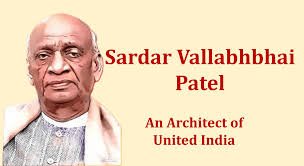Sardar Vallabhbhai Patel – The Bismarck of India & His Role in Unifying India
Sardar Vallabhbhai Patel, often referred to as the “Bismarck of India,” played a pivotal role in unifying over 500 princely states into the Indian Union post-independence. His strategic acumen and unwavering determination were instrumental in shaping modern India.
Early Life and Rise to Prominence
Born on October 31, 1875, in Nadiad, Gujarat, Patel pursued a career in law, establishing himself as a successful barrister. His involvement in the Indian freedom struggle began with his leadership in the Kheda and Bardoli Satyagrahas, where he mobilized peasants against oppressive British policies. These movements not only alleviated the immediate grievances of the farmers but also showcased Patel’s organizational skills and commitment to justice.
The Challenge of Unifying Princely States
At the time of India’s independence in 1947, the subcontinent was a mosaic of British-controlled territories and autonomous princely states. The latter, numbering over 500, had the option to join either India or Pakistan or remain independent. This posed a significant challenge to the vision of a unified India. Patel, as the first Home Minister and Deputy Prime Minister, took on the monumental task of persuading these states to accede to India.
Strategic Diplomacy and Statesmanship
Patel employed a combination of diplomacy, persuasion, and, when necessary, decisive action to integrate the princely states. He assured the rulers of their privileges and offered favorable terms, including privy purses, to secure their cooperation. His pragmatic approach ensured that by 1950, almost all princely states had integrated into the Indian Union, laying the foundation for a strong, centralized nation. This achievement drew parallels to Otto von Bismarck’s unification of Germany, earning Patel the moniker “Bismarck of India.”
Legacy and Commemoration
Patel’s legacy as the architect of a unified India is immortalized by the “Statue of Unity” in Gujarat, standing at 182 meters as the world’s tallest statue. Inaugurated on October 31, 2018, this monument symbolizes national unity and serves as a testament to Patel’s enduring contributions to India’s nation-building.

Why This News Is Important
Relevance to Competitive Exams
Understanding Sardar Vallabhbhai Patel’s role in India’s unification is crucial for aspirants of government exams, especially those focusing on history, polity, and governance. His strategies in integrating princely states are often highlighted in questions related to post-independence consolidation.
Inspiration for Leadership and Governance
Patel’s pragmatic approach to problem-solving and his steadfast commitment to national unity offer valuable lessons in leadership and governance. Exam candidates can draw inspiration from his methods, applying similar principles to case studies and situational analyses.
Historical Context
The Princely States and British Paramountcy
Before independence, India was divided into British-administered provinces and princely states under British suzerainty. These states enjoyed autonomy in internal matters but recognized British supremacy. The withdrawal of British paramountcy in 1947 left these states with the choice to join India, Pakistan, or remain independent, leading to potential fragmentation.
Patel’s Vision for a Unified India
Recognizing the dangers of a fragmented nation, Patel envisioned a cohesive India. He collaborated with V.P. Menon to devise strategies that combined incentives with assertive diplomacy, ensuring the seamless integration of princely states into the Indian Union.
Key Takeaways from Sardar Vallabhbhai Patel’s Role in Unification
| S.No. | Key Takeaway |
|---|---|
| 1 | Sardar Vallabhbhai Patel was instrumental in unifying over 500 princely states into India. |
| 2 | His approach combined diplomacy, persuasion, and decisive action. |
| 3 | Patel’s efforts prevented the potential Balkanization of post-independence India. |
| 4 | He earned the title “Bismarck of India” for his unification strategies. |
| 5 | The “Statue of Unity” in Gujarat commemorates his contributions to national integration. |
Important FAQs for Students from this News
Q1: Why is Sardar Vallabhbhai Patel called the “Bismarck of India”?
A1: Sardar Vallabhbhai Patel is referred to as the “Bismarck of India” due to his pivotal role in unifying over 500 princely states into the Indian Union after independence, similar to Otto von Bismarck’s unification of Germany.
Q2: What strategies did Patel use to integrate the princely states?
A2: Patel employed a mix of diplomacy, persuasion, and, when necessary, decisive action. He offered favorable terms, including assurances of privileges and privy purses, to the rulers, ensuring their cooperation in joining the Indian Union.
Q3: What was the significance of the “Statue of Unity”?
A3: Inaugurated on October 31, 2018, the “Statue of Unity” in Gujarat stands as the world’s tallest statue at 182 meters. It commemorates Sardar Patel’s monumental efforts in unifying India and symbolizes national unity.
Q4: How did Patel’s actions prevent the fragmentation of post-independence India?
A4: By persuading and integrating the numerous princely states into the Indian Union, Patel averted potential divisions and the emergence of multiple independent entities, ensuring a cohesive and unified nation.
Q5: In what ways is Patel’s leadership relevant to current governance?
A5: Patel’s pragmatic approach, strategic foresight, and unwavering commitment to national unity serve as enduring lessons in effective leadership and governance, offering valuable insights for contemporary policymakers and administrators.
Some Important Current Affairs Links


















